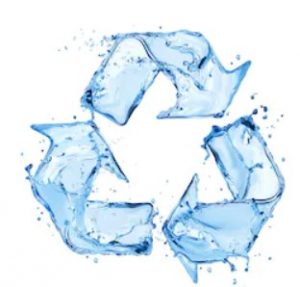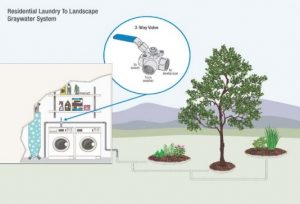Graywater: Are You Wasting Good Water?
Are you wasting good water?
Chances are you may be overlooking outdoor water savings that can amount to 12,000 gallons of water a year.
By using the same water that washed your clothes (or graywater) to water your landscape, you can reduce the amount of drinking water used for landscape irrigation and reduce water entering our sewer system. Using graywater can help conserve precious drinking water supplies, and decrease water and wastewater utility bills.
Please note that the water-saving benefits of using graywater will depend on your landscape’s needs, your water usage, and your graywater system.
What is graywater?
Graywater is lightly used household water from showers, bathtubs, clothes washing machines, and bathroom sinks. It does not include wastewater from toilets, kitchen sinks, dishwashers, or laundry water with soiled diapers.
Graywater includes some soap, but is clean enough to water plants in your landscape, especially ornamental and larger plants, such as trees, bushes, and shrubs. One of the simplest and most common graywater systems in residential settings is Laundry-to-Landscape.
A L2L system diverts water used in your washing machine into your landscape. When completed as a “Do-It-Yourself” project, the cost to install this system is about $200-$300.
How does a L2L system work?
A L2L system captures graywater from the drain hose of a washing machine and connects to a three-way diverter valve which allows graywater to be directed to either the landscape or the sewer system.
The water is distributed subsurface through 1-inch irrigation tubing with 1/2″ outlets to water specific plants. The L2L system is typically the lowest in cost and easiest to install.
Is it safe to use graywater?
Graywater is safe to use if you follow procedures and guidelines for constructing, maintaining, and using your graywater system. A safe graywater system is designed to minimize contact with humans and pets.
Additionally, the system should use plant-friendly soap products in order to protect your plants and soil. To help your plants thrive, customers should consider using plant-friendly laundry detergents that don’t contain sodium (salt), boron and chlorine bleach.
Do I need a permit to install a L2L graywater system?
While permits are not required for a L2L system in California as long as it complies with the California Plumbing Code, each municipality may have additional requirements.
After viewing the video below for more information on installing a L2L system, please see the list of additional resources to connect with your local government for requirements in your area.
Graywater Requirements and Resources by City
- City of Encinitas
- City of Solana Beach
- City of San Marcos
- San Diego County (for unincorporated areas)
- City of Carlsbad – Inquiries can be made to Carlsbad Municipal Water District at 442-339-2722.
Other helpful resources
- Solana Center (local graywater workshops and resources)
- Oasis Design (in-depth graywater information from the original developer of the Laundry-to-Landscape system)
- Greywater Action (knowledgebase for graywater systems, rainwater harvesting, and even composting toilets)
- The San Diego Sustainable Living Institute offers Laundry-to-Landscape graywater workshops.
- Additionally, some customers have expressed interest in graywater reuse products that are in development such as LeapFrog Design (for informational purposes only, not a company endorsement).




